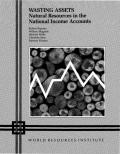The New Zealand Energy Monetary Stock Account (1987 - 2001) presents the environmental asset value of energy resources in New Zealand. The country’s energy resources include non-renewable resources (coal, gas, and oil) and renewable energy resources (biogas, biomass, geothermal energy, hydro energy, solar energy, and wind energy).
This report addresses the issue of sustainable development in Namibia, an economy dependent on mineral resources. While mineral wealth can provide countries with an opportunity for economic development, resource abundance does not necessarily lead to economic prosperity. In Namibia, the mining sector is critical to the economy and mineral assets form a major source of national wealth. However, the national accounts give a distorted picture of economic health because they record the contribution of mining to GDP but not to the simultaneous depletion of mineral wealth.
This case study, Accounting for National Resources in Ecuador: Contrasting Methodologies, Conflicting Results, published by the World Bank, examines natural capital depletion in Ecuador from 1971 to 1990, corresponding with an oil boom in the 1970s followed by economic stagnation in the 1980s. Two natural resource accounting (NRA) methodologies are utilized to measure the economic value of natural capital depletion in the petroleum sector: the Depreciation Method and the User Cost Method.
This report examines the potential policy uses of the different varieties of resource and environmental accounts, particularly greener national accounting aggregates such as genuine savings and 'Eco-Domestic Product'.
This report details the United Nations Economic Commission for Europe (UNECE) Standard Statistical Classifications for the Environment, including definitions of terms, selected national practices in estimations of air and water emissions, materials balance sheets, and a bibliography of methodological papers.
This paper presents the results of a case study, carried out in 1990 and 1991, with the objective of integrating and linking environmental and economic information and to explore whether environmentally-adjusted national product aggregates for Mexico can be derived. This work was carried out within the overall analytical framework developed in UNSC's Draft Handbook on Environmental Accounting.

This report demonstrates that natural resources can be treated similarly to capital in national accounts, and it argues that these accounts should be revised. Using data from Indonesia, the study provides a concrete example of how the revised accounts would work and what signals the new results would give to those who make decisions about economic development.
The case study describes the calculation of the loss of values of an important wetland area in Hungary using the method of benefit transfer.
This case study describes a practical experience of biodiversity valuation in the Czech Republic. The methodology for estimating environmental values of biotypes, originally developed in the Hesse federal state of Germany, was used and applied on the three levels: local (Tlustec case study), regional (highway D8 project) and national (nation-wide evaluation of biotopes of the Czech Republic).
The paper discusses a compilation of economic accounts for wild fish stocks. The methods proposed in the System of National Accounting (SNA) satellite system and the System for Integrated Environmental and Economic Accounting (SEEA) are discussed and their usefulness is assessed through examples.
